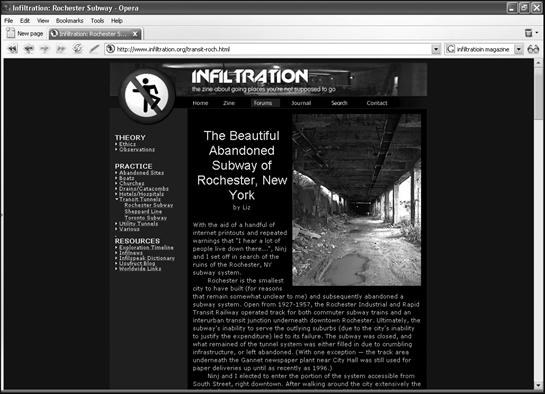Rather than pay to visit an amusement park and absorb its sanitized experiences, many hackers prefer the excitement and unpredictability of exploring the buildings around them for free. Urban explorers often tour abandoned buildings for their historical value (shut-down subway tunnels, empty factories, boarded-up hotels, or abandoned missile silos). They also enjoy prowling around buildings currently in use, such as utility tunnels beneath a convention center, the roofs of warehouses, or construction sites. If the general public would normally never see it, the urban explorer wants to be there.
Although the idea of crawling through an old sewage pipe or wading through stagnant water in the bottom of an abandoned mine shaft might not sound appealing, it's no more uncomfortable than camping in a forest and enduring mosquito bites, bird droppings, and primitive toilet facilities (or spending five days a week in a sterile office cubicle, locked in a business suit, with eye-irritating fluorescent lighting, while counting the hours until your escape).
The urban explorer's goal is to wander and explore as a modern-day archaeologist, admiring the wonders around us. To learn more about the fine art of urban exploring, visit Infiltration Magazine (www.infiltration.org), as shown in Figure 3-4. This magazine provides urban exploring tips that range from the plainly practical (wear comfortable clothes and thick-soled shoes, and bring a flashlight) to the more obscure (grappling hooks can be handy for scaling buildings but impractical to hide if confronted by a security guard).
Figure 3-4. Infiltration Magazine offers plenty of stories and pictures to encourage you on the proper techniques for infiltrating urban areas.
The goal of urban exploration isn't to steal or deface anything, but simply to look around, even if that involves a little bit of trespassing. Sometimes this might require social engineering (to get past a security guard or to avoid arrest when confronted by one), a little bit of stamina (to climb stairs or crawl through holes in walls), and a lot of problem solving (to figure out how to cross an I-beam three stories up without falling so that you can escape from aggressive guard dogs).
Urban exploring can prove embarrassing (and useful) to governments. For example, the Russian urban exploring group Diggers of the Underground Planet once found a secret subway system under Moscow that Stalin reportedly had built to allow government authorities a quick escape from the city in an emergency. The acquired knowledge of these same urban explorers came in handy in October 2002, when Chechen rebels took over a Moscow theater and held more than 900 people hostage. Vadim Mikhailov of the Diggers of the Underground Planet led Russian authorities to the theater through a little-known underground route, of which neither the rebels nor the authorities were even aware.
Whether urban explorers want to see the employee lounge in the basement of a five-star hotel or map out the steam tunnels beneath a college campus, the goal is to have fun, see something cool that can be talked about later, and get back in one piece to do it again.
